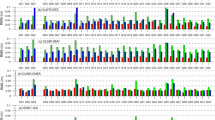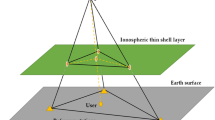Abstract
The long (re-)convergence time seriously limits many applications of real-time precise point positioning (RTPPP) in challenging environments like urban vehicle navigation and hazards monitoring. Thus, we proposed a real-time fast-positioning model by introducing the regional between-satellite single-differenced (SD) ionospheric constraints into the undifferenced and uncombined PPP (UU-PPP). The line-of-sight ionospheric observables are extracted by the multi-GNSS (GPS + Galileo) UU-PPP method. The polynomial function with simple structure and high efficiency is applied to establish the real-time regional between-satellite SD ionospheric vertical total electron content (VTEC) model. The differential slant total electron content (dSTEC) variations retrieved from three VTEC models are validated with the between-satellite SD and epoch-differenced geometry-free combinations of dual-frequency phase observations. The average RMS values are 0.77, 0.78 and 0.47 TEC unit for the CLK93 real-time VTEC, CODE final GIM and regional between-satellite SD ionospheric VTEC model, respectively. In the positioning domain, the data of ten stations for 12 consecutive days in 2020 were used for implementing kinematic RTPPP with single-frequency (SF) and dual-frequency (DF) observations. Compared with the GPS + Galileo SF-RTPPP based on the GRoup And PHase Ionospheric Correction model, the initialization time of the SD ionospheric-constrained (SDIC) SF-RTPPP when converged to 0.2 m at the 68% confidence level can be improved from 58 to 32 min in horizontal and 72 to 49 min in vertical, and its positioning accuracy can be improved by 29.7 and 20.3% in the horizontal and vertical components, respectively. Meanwhile, the re-convergence errors of SDIC SF-RTPPP from the first epoch can be maintained at 0.15 m in three components. As to GPS + Galileo SDIC DF-RTPPP, the re-convergence time when converged to 0.1 m can be lower than 3 min in horizontal and 9 min in vertical, and the re-convergence errors at the first epoch could even be lower than 0.15 m in horizontal. Hence, the new positioning model can maintain high accuracy and improve the continuity of real-time kinematic positioning in a short time when the number of tracked satellites in the urban or canyon environment was greatly dropped due to signal blocking.













Similar content being viewed by others
Data availability
The GNSS data are provided by the Asia–Pacific Reference Frame (APREF) network, which are available from ftp://ftp.ga.gov.au/geodesy-outgoing/gnss/data/. The merging broadcast ephemeris file (BRDM) is routinely generated as part of the Multi-GNSS Experiment (MGEX) at ftp://cddis.gsfc.nasa.gov/pub/gps/data/campaign/mgex/daily/rinex3/. The DCB and Center for Orbit Determination in Europe (CODE) GIM products are provided by the IGS analysis center at ftps://gdc.cddis.eosdis.nasa.gov/gnss/products/.
References
Ahmed F, Vaclavovic P, Teferle FN, Dousa J, Bingley R, Laurichesse D (2016) Comparative analysis of real-time precise point positioning zenith total delay estimates. GPS Solut 20:187–199
Caissy M, Agrotis L (2011) Real-time working group and real-time pilot project. Int GNSS Serv Tech Rep 2011:183–190
Chang Z, Hu X, Guo R, Cao Y, Wu X, Wang A, Dong E (2015) Comparison between CNMC and hatch filter & its precision analysis for BDS precise relative positioning (in Chinese). Sci Sin-Phys Mech Astron 45(7):079508
Chen L, Yi W, Song W, Shi C, Lou Y, Cao C (2018) Evaluation of three ionospheric delay computation methods for ground-based GNSS receivers. GPS Solut 22:125
Ciraolo L, Azpilicueta F, Brunini C, Meza A, Radicella SM (2007) Calibration errors on experimental slant total electron content (TEC) determined with GPS. J Geod 81:111–120
Feltens J, Angling M, Jackson-Booth N, Jakowski N, Hoque M, Hernandez-Pajares M, Aragon-Angel A, Orus R, Zandbergen R (2011) Comparative testing of four ionospheric models driven with GPS measurements. Radio Sci 46(6):1–11
Geng J, Bock Y (2016) GLONASS fractional-cycle bias estimation across inhomogeneous receivers for PPP ambiguity resolution. J Geod 90:379–396
Geng J, Meng X, Dodson AH, Ge M, Teferle FN (2010) Rapid re-convergences to ambiguity-fixed solutions in precise point positioning. J Geod 84:705–714
Guo F, Li X, Zhang X, Wang J (2017) The contribution of multi-GNSS experiment (MGEX) to precise point positioning. Adv Space Res 59:2714–2725
Hadas T, Bosy J (2015) IGS RTS precise orbits and clocks verification and quality degradation over time. GPS Solut 19(1):93–105
Hadas T, Kazmierski K, Sosnica K (2019) Performance of Galileo-only dual-frequency absolute positioning using the fully serviceable Galileo constellation. GPS Solut 23:108
Kazmierski K, Sosnica K, Hadas T (2018) Quality assessment of multi-GNSS orbits and clocks for real-time precise point positioning. GPS Solut 22:11
Kazmierski K, Zajdel R, Sosnica K (2020) Evolution of orbit and clock quality for real-time multi-GNSS solutions. GPS Solut 24:111
Kouba J, Heroux P (2001) Precise point positioning using IGS orbit and clock products. GPS Solut 5(2):12–28
Laurichesse D, Blot A (2016) Fast PPP convergence using multi-constellation and triple-frequency ambiguity resolution. In: Proceedings of ION GNSS+ 2016, Portland, Oregon, September 2016 pp. 2082–2088
Li X, Zhang X, Ge M (2011) Regional reference network augmented precise point positioning for instantaneous ambiguity resolution. J Geod 85:151–158
Li B, Zang N, Ge H, Shen Y (2019) Single-frequency PPP models: analytical and numerical comparison. J Geod 93:2499–2514
Li Z, Wang N, Hernandez-Pajares M, Yuan Y, Krankowski A, Liu A, Zha J, Garcia-Rigo A, Roma-Dollase D, Yang H, Laurichesse D, Blot A (2020) IGS real-time service for global ionospheric total electron content modeling. J Geod 94:32
Liu T, Yuan Y, Zhang B, Wang N, Tan B, Chen Y (2017) Multi-GNSS precise point positioning (MGPPP) using raw observations. J Geod 91:253–268
Liu T, Zhang B, Yuan Y, Li M (2018) Real-time precise point positioning (RTPPP) with raw observations and its application in real-time regional ionospheric VTEC modeling. J Geod 92(11):1267–1283
Liu T, Jiang W, Laurichesse D, Chen H, Liu X, Wang J (2020) Assessing GPS/Galileo real-time precise point positioning with ambiguity resolution based on phase biases from CNES. Adv Space Res 66(4):810–825
Lou Y, Zheng F, Gu S, Wang C, Guo H, Feng Y (2016) Multi-GNSS precise point positioning with raw single-frequency and dual-frequency measurement models. GPS Solut 20:849–862
Malys S, Jensen PA (1990) Geodetic point positioning with GPS carrier beat phase data from the CASA UNO experiment. Geophys Res Lett 17(5):651–654
Nie Z, Yang H, Zhou P, Gao Y, Wang Z (2019) Quality assessment of CNES real-time ionospheric products. GPS Solut 23:11
Petit G, Jiang Z (2008) Precise point positioning for TAI computation. Int J Navig Obs 2008:562878. https://doi.org/10.1155/2008/562878
Sanz J, Miguel Juan J, Rovira-Garcia A, Gonzalez-Casado G (2017) GPS differential code biases determination: methodology and analysis. GPS Solut 21(4):1549–1561
Schaer S (1999) Mapping and predicting the earth’s ionosphere using the global positioning system. Ph.D. Dissertation, University of Berne, Switzerland
Shi C, Gu S, Lou Y, Ge M (2012) An improved approach to model ionospheric delays for single-frequency precise point positioning. Adv Space Res 49:1698–1708
Wang A, Chen J, Zhang Y, Meng L, Wang J (2019) Performance of selected ionospheric models in multi-global navigation satellite system single-frequency positioning over China. Remote Sens 11:2070
Wang A, Chen J, Zhang Y, Meng L, Wang B, Wang J (2020a) Evaluating the impact of CNES real-time ionospheric products on multi-GNSS single-frequency positioning using the IGS real-time service. Adv Space Res 66(11):2516–2527
Wang A, Chen J, Zhang Y, Wang J (2020b) Comparison of three widely used multi-GNSS real-time single-frequency precise point positioning models using the international GNSS service real-time service. IET Radar Sonar Navig 14:1726–1734
Wright TJ, Houlie N, Hildyard M, Iwabuchi T (2012) Real-time, reliable magnitudes for large earthquakes from 1 Hz GPS precise point positioning: the 2011 Tohoku-Oki (Japan) earthquake. Geophys Res Lett 39(12):L12302
Zhang B, Ou J, Yuan Y, Li Z (2012) Extraction of line-of-sight ionospheric observables from GPS data using precise point positioning. Sci China Earth Sci 55:1919–1928
Zhang Y, Chen J, Gong X, Chen Q (2020) The update of BDS-2 TGD and its impact on positioning. Adv Space Res 65(11):2645–2661
Zhou F, Dong D, Li P, Li X, Schuh H (2019) Influence of stochastic modeling for inter-system biases on multi-GNSS undifferenced and uncombined precise point positioning. GPS Solut 23:59
Zumberge JF, Heflin MB, Jefferson DC, Watkins MM, Webb FH (1997) Precise point positioning for the efficient and robust analysis of GPS data from large networks. J Geophys Res 102(B3):5005–5017
Acknowledgements
The authors would like to thank the GA (Geoscience Australia), CNES, GFZ and CODE for the provision of APREF observation data, real-time data streams including SSR satellite orbit and clock corrections as well as the VTEC products, final precise satellite orbits and clocks, post-processed DCB and final GIM products. Funded by State Key Laboratory of Geo-Information Engineering and Key Laboratory of Surveying and Mapping Science and Geospatial Information Technology of MNR, CASM (No. 2021-01-08); the National Natural Science Foundation of China (No. 11673050); the Key R&D Program of Guangdong province (No. 2018B030325001).
Author information
Authors and Affiliations
Corresponding author
Additional information
Publisher's Note
Springer Nature remains neutral with regard to jurisdictional claims in published maps and institutional affiliations.
Rights and permissions
About this article
Cite this article
Wang, A., Zhang, Y., Chen, J. et al. Improving the (re-)convergence of multi-GNSS real-time precise point positioning through regional between-satellite single-differenced ionospheric augmentation. GPS Solut 26, 39 (2022). https://doi.org/10.1007/s10291-022-01229-z
Received:
Accepted:
Published:
DOI: https://doi.org/10.1007/s10291-022-01229-z




